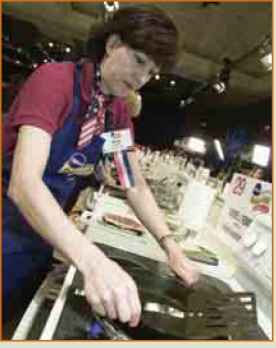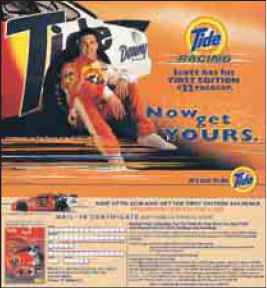Sales Promotion Has an Interesting History as Well
Advertising has a long and fascinating history and has had a major impact, both good and bad, on our culture. Advertising has entertained, moved, and motivated consumers for more than

a century, and many of the images created by advertisers have become cultural icons—Ronald McDonald, the Marlboro Man, Tony the Tiger, and the Energizer Bunny, to name just a few. Much has been written about the history of advertising and how it reflects society and its whole range of activities. However, sales promotion also has a very rich and interesting history: Marketers have developed and used a variety of techniques over the past century to give consumers an extra incentive to use their products and services. Many of the sales promotion offers that motivate consumers today and have become part of their everyday lives have been around for nearly a century or more.
The oldest, most widely used, and most effective sales promotion tool is the cents-off coupon.
Coupons have been around since 1895 when the C.W. Post Co. first began using the penny-off coupon to help sell its new Grape Nuts cereal brand. Procter & Gamble began using coupons in 1920, and its first ones were metal coins that were good for discounts or buy-one-get-one-free deals. Those were soon replaced by cheaper, more convenient paper versions, which have been around ever since. Another classic promotional tool is the premium offer, which dates back to 1912 when Cracker Jack began offering "a prize in every box." Ovaltine developed one of the first interactive premiums in 1930, when it gave away decoder rings that were needed to decode secret messages broadcast in Little Orphan Annie radio shows in the 30s. The promotion was brought back 20 years later as television became the new mass medium and the rings were used to decode messages in Texas Rangers TV shows. Perhaps no company has used premium offers as effectively as McDonald's, which launched its Happy Meals in 1979 and has been using them ever since. Happy Meals account for a significant portion of McDonald's sales and have made the company the world's largest toy manufacturer.
Marketers also have a long history of taking their promotional programs to the customer. The first Oscar Mayer Wienermobile hit the streets in 1936, when the nephew of the company's founder had the idea of introducing a 13-foot-long hot dog on wheels. Soon it was seen driving the streets of Chicago, promoting Oscar Mayer "German Style Wieners." Seven updates and 66 years later, there is now a fleet of eight Wienermobiles that cruise the highways of America and other countries playing 21 versions of the famous Wiener Jingle and helping to promote the brand. Pepsi is another company that took a promotional program on the road, with its launch of the famous "Pepsi Challenge" in 1975, which was one of the most successful promotions ever used to attract users of a competing brand. Pepsi took on its archrival and industry leader Coca-Cola in a hard-hitting promotion that challenged consumers to taste the two brands in blind taste tests. Pepsi ran the challenge promotion for nearly a decade and relaunched it again in 2000 as it began cruising for a new generation.
Contests and sweepstakes also have an interesting history. Pillsbury launched its first Bake-Off Contest in 1949, when the company's advertising agency created the contest to celebrate the company's 80th birthday and invited homemakers to share their treasured recipes. The response was so great that Pillsbury decided to hold the contest again in subsequent years, and the Bake-Off has become an institution as well as the nation's most prestigious cooking competition. Many of the winning recipes in each year's competition have become part of the repertoire of home cooks and have led to innovative new products from Pillsbury.
McDonald's has taken another institution, the world-famous Monopoly board game, and turned it into a long-running and immensely popular contest. The first McDonald's Monopoly game contest was in 1987, and its collect-and-win format and big prizes generated tremendous interest and excitement and was very effective at generating repeat business. McDonald's began running the game annually in 1991, tweaking it each year by adding new partners and prizes and making the game more complex with new iterations such as the Pick Your Prize twist. However, in 2001 the game had the most surprising twist of all: The FBI used it to collect evidence against an embezzlement ring that had been stealing high-value game pieces throughout the years. It remains to be seen if McDonald's will try to bring back the popular game.
Another promotional program of historical significance is the American Airlines AAdvantage frequent-flier program, which was launched in 1981. The program created a new currency and has set the gold standard for loyalty marketing as it now has nearly 44 million members. American also has a steady stream of partners that offer AAdvantage miles as an incentive to encourage consumers to purchase their products and services. Loyalty programs have also become very prevalent in many other industries such as hospitality, rental cars, and retailing.
Many of the marketers discussed here are promotional pioneers, as they have found creative ways to provide consumers with an extra incentive to purchase their brands. The success of these promotions has had a major impact on consumers throughout the years and also has resulted in similar programs being developed by competitors. Such promotions show that advertising is not the only IMC tool with a rich and interesting history.
Sources: "A Look at 16 Campaigns That Helped Redefine Promotion Marketing," Promo, March 2002, pp. 58-70; www.bakeoff.com/history.
As discussed in the opening vignette, marketers have come to recognize that advertising alone is not always enough to move their products off store shelves and into the hands of consumers. Companies also use sales promotion methods targeted at both consumers and the wholesalers and retailers that distribute their products to stimulate demand. Most companies' integrated marketing communications programs include consumer and trade promotions that are coordinated with advertising, direct marketing, and publicity/public relations campaigns as well as sales force efforts.
This chapter focuses on the role of sales promotion in a firm's IMC program. We examine how marketers use both consumer- and trade-oriented promotions to influence the purchase behavior of consumers as well as wholesalers and retailers. We explore the objectives of sales promotion programs and the various types of sales promotion tools that can be used at both the consumer and trade level. We also consider how sales promotion can be integrated with other elements of the promotional mix and look at problems that can arise when marketers become overly dependent on con-512 sumer and trade promotions, especially the latter.
Sales promotion has been defined as "a direct inducement that offers an extra value or incentive for the product to the sales force, distributors, or the ultimate consumer with the primary objective of creating an immediate sale."1 Keep in mind several important aspects of sales promotion as you read this chapter.
First, sales promotion involves some type of inducement that provides an extra incentive to buy. This incentive is usually the key element in a promotional program; it may be a coupon or price reduction, the opportunity to enter a contest or sweepstakes, a money-back refund or rebate, or an extra amount of a product. The incentive may also be a free sample of the product, given in hopes of generating a future purchase, or a premium that serves as a reminder of the brand and reinforces its image, such as the miniature race car premium offer that ties into Tide's NASCAR sponsorship (Exhibit 16-1). Most sales promotion offers attempt to add some value to the product or service. While advertising appeals to the mind and emotions to give the consumer a reason to buy, sales promotion appeals more to the pocketbook and provides an incentive for purchasing a brand.
Sales promotion can also provide an inducement to marketing intermediaries such as wholesalers and retailers. A trade allowance or discount gives retailers a financial incentive to stock and promote a manufacturer's products. A trade contest directed toward wholesalers or retail personnel gives them extra incentive to perform certain tasks or meet sales goals.
A second point is that sales promotion is essentially an acceleration tool, designed to speed up the selling process and maximize sales volume.2 By providing an extra incentive, sales promotion techniques can motivate consumers to purchase a larger quantity of a brand or shorten the purchase cycle of the trade or consumers by encouraging them to take more immediate action.
Companies also use limited-time offers such as price-off deals to retailers or a coupon with an expiration date to accelerate the purchase process.3 Sales promotion attempts to maximize sales volume by motivating customers who have not responded to advertising. The ideal sales promotion program generates sales that would not be achieved by other means. However, as we shall see later, many sales promotion offers end up being used by current users of a brand rather than attracting new users.
A final point regarding sales promotion activities is that they can be targeted to different parties in the marketing channel. As shown in Figure 16-1, sales promotion can be broken into two major categories: consumer-oriented and trade-oriented promotions. Activities involved in consumer-oriented sales promotion include sampling, couponing, premiums, contests and sweepstakes, refunds and rebates, bonus packs, price-offs, frequency programs, and event marketing. These promotions are directed at consumers, the end purchasers of goods and services, and are designed to induce them to purchase the marketer's brand.
As discussed in Chapter 2, consumer-oriented promotions are part of a promotional pull strategy; they work along with advertising to encourage consumers to purchase a particular brand and thus create demand for it. Consumer promotions are also used by retailers to encourage consumers to shop in their particular stores. Many grocery stores use their own coupons or sponsor contests and other promotions to increase store patronage.
Trade-oriented sales promotion includes dealer contests and incentives, trade allowances, point-of-purchase displays, sales training programs, trade shows, cooperative advertising, and other programs designed to motivate distributors and retailers to carry a product and make an extra effort to push it to their customers. Many marketing programs include both trade- and consumer-oriented promotions, since motivating both groups maximizes the effectiveness of the promotional program.
The Scope and Role of Sales Promotion
Exhibit 16-1 Procter & Gamble offers a premium offer to provide extra incentive to purchase Tide and Downy

Continue reading here: The Growth of Sales Promotion
Was this article helpful?
Readers' Questions
-
cosma17 days ago
- Reply
-
jenni1 year ago
- Reply
-
alana1 year ago
- Reply
-
HABEN1 year ago
- Reply
-
valtteri1 year ago
- Reply
-
Peony1 year ago
- Reply
-
carolyn1 year ago
- Reply